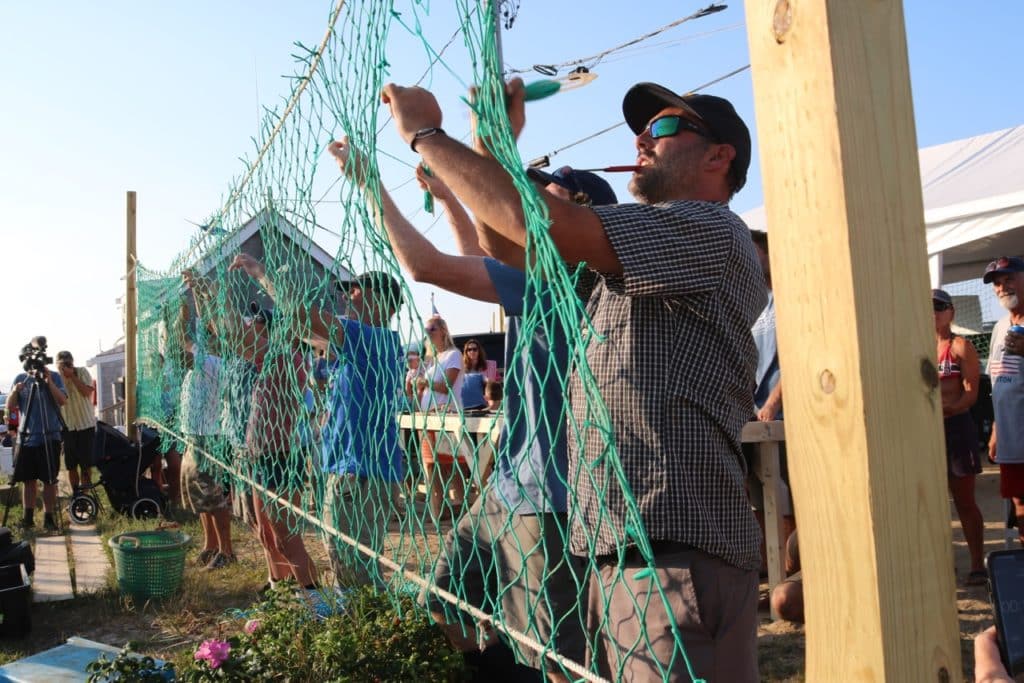
A week’s sailing adventure in early August began with me cursing an offseason nor’easter that nicked southern New England and delayed our departure by a couple of days. But then, mostly sunny days, favorable breezes and fair currents prevailed every time my wife, Sue, and I hoisted the main. And in the end, I was actually thankful, in an odd sort of way, when our new itinerary kept us a little closer to home and we landed in Menemsha, at the southwest tip of Martha’s Vineyard. It’s a harbor we’d always overlooked as we dashed up and down Buzzards Bay or Vineyard Sound, bound for more far-flung waypoints.
It turns out, the anchorage in Menemsha Bight, outside the town’s tight inner basin, is a lovely spot to stop for a night in settled conditions. Better yet, during a summer filled with news about how seemingly no one can get along with anyone else, we found ourselves ashore just in time for the island’s third annual Meet the Fleet celebration in support of the Vineyard’s fragile fishing industry. Good vibes were definitely the catch of the day.
The dock party was organized by the Martha’s Vineyard Fishermen’s Preservation Trust, a nonprofit formed in 2011 by residents concerned that fishing as a commercial livelihood was dying because of dwindling stocks, tighter regulations and the high cost of entry. For the past three years, the group’s been quite active, meeting every two weeks to get ideas to jell. Then, in January, Shelley Edmundson, one of the regular attendees, came on as executive director. It’s not a coincidence that she recently earned her doctorate in marine biology, studying channeled whelk, large marine snails that are often confused with conchs because of the shape of their shells. Whelk is considered a delicacy in Asia, and it is now the Vineyard’s largest fishery. It’s caught using baited traps, much the same way lobsters are harvested, and many of the Vineyard’s 25 or so whelk fishermen also carry lobster permits.
So far, besides building bridges between the island’s 50 or so offshore fishermen and local markets and restaurants willing to buy their catch, the trust has come up with a couple of programs to help young Vineyarders get a toe in the water, and to nurture the existing fishing industry, which includes whelk, lobster, sea bass, ground fish, oysters and clams.
In 2016, Luke Gurney, a local whelk fisherman, husband and father of two young children, was lost at sea off Nantucket in a fishing accident. In the aftermath, the trust worked with Massachusetts officials on a pilot program to buy Gurney’s fishing permit and lease it on a rotating basis to an islander hoping to break into the business. Edmundson says teenagers might work on boats and eventually be able to save enough to buy one of their own, but they then need to come up with another $30,000 to $50,000 for the necessary permits. Luke’s Legacy was set up to help them become established on their own.
This past year the trust also raised money through donations and creative financing to buy $1 million worth of scallops quota, or about 0.1 percent of each year’s federally allowable catch. This translates into about 17,000 pounds in 2017. The quota can be leased to local fishermen at a reduced rate to help them keep their businesses stable and profitable, and hopefully, it will mean more local scallops end up on Vineyard tables.
Next in the works is some sort of scallop-share program, so residents can buy in and take advantage of the locally caught shellfish.
“It’s just so expensive to go fishing these days. It’s crazy,” says Edmundson, who worked with many of the local fishermen, including Gurney, during her graduate research. She sees both the commercial and scientific value of promoting a locally sustainable industry.
“Keeping the fishermen fishing is important for so many overlying areas: seafood for the community, science for the regulators and, especially for the island, for the heritage of the island. If we didn’t have fishermen, it would be really sad.”
On a sunny August Thursday afternoon, it was the fishermen who were in abundance on Dutcher Dock, in Menemsha’s inner harbor. Workboats came from several of the other Vineyard ports, and the classic Eastern-rigged dragger Roann, built in the 1940s in Thomaston, Maine, and now berthed at Mystic Seaport, paid a visit, along with Coast Guard and Environmental Police boats. Tisbury country blues and Americana folk band Good Night Louise played aboard the fishing boat Martha Elizabeth, tied stern to at the pier. Ashore, a crowd took in net-mending and scallop-shucking contests, crab races and all sorts of interesting displays designed to entertain and inform.
It was the sort of by-happenstance afternoon that could make a summer vacation. And, in fact, it did.








